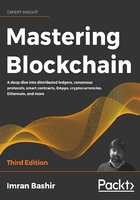
Methods of decentralization
Two methods can be used to achieve decentralization: disintermediation and competition. These methods will be discussed in detail in the sections that follow.
Disintermediation
The concept of disintermediation can be explained with the aid of an example. Imagine that you want to send money to a friend in another country. You go to a bank, which, for a fee, will transfer your money to the bank in that country. In this case, the bank maintains a central database that is updated, confirming that you have sent the money. With blockchain technology, it is possible to send this money directly to your friend without the need for a bank. All you need is the address of your friend on the blockchain. This way, the intermediary (that is, the bank) is no longer required, and decentralization is achieved by disintermediation. It is debatable, however, how practical decentralization through disintermediation is in the financial sector due to the massive regulatory and compliance requirements. Nevertheless, this model can be used not only in finance but in many other industries as well, such as health, law, and the public sector. In the health industry, where patients, instead of relying on a trusted third party (such as the hospital record system) can be in full control of their own identity and their data that they can share directly with only those entities that they trust. As a general solution, blockchain can serve as a decentralized health record management system where health records can be exchanged securely and directly between different entities (hospitals, pharmaceutical companies, patients) globally without any central authority.
Contest-driven decentralization
In the method involving competition, different service providers compete with each other in order to be selected for the provision of services by the system. This paradigm does not achieve complete decentralization. However, to a certain degree, it ensures that an intermediary or service provider is not monopolizing the service. In the context of blockchain technology, a system can be envisioned in which smart contracts can choose an external data provider from a large number of providers based on their reputation, previous score, reviews, and quality of service.
This method will not result in full decentralization, but it allows smart contracts to make a free choice based on the criteria just mentioned. This way, an environment of competition is cultivated among service providers where they compete with each other to become the data provider of choice.
In the following diagram, varying levels of decentralization are shown. On the left side, the conventional approach is shown where a central system is in control; on the right side, complete disintermediation is achieved, as intermediaries are entirely removed. Competing intermediaries or service providers are shown in the center. At that level, intermediaries or service providers are selected based on reputation or voting, thus achieving partial decentralization:

Figure 2.5: Scale of decentralization
There are many benefits of decentralization, including transparency, efficiency, cost saving, development of trusted ecosystems, and in some cases privacy and anonymity. Some challenges, such as security requirements, software bugs, and human error, need to be examined thoroughly.
For example, in a decentralized system such as Bitcoin or Ethereum where security is normally provided by private keys, how can we ensure that an asset or a token associated with these private keys cannot be rendered useless due to negligence or bugs in the code? What if the private keys are lost due to user negligence? What if due to a bug in the smart contract code the decentralized application becomes vulnerable to attack?
Before embarking on a journey to decentralize everything using blockchain and decentralized applications, it is essential that we understand that not everything can or needs to be decentralized.
This view raises some fundamental questions. Is a blockchain really needed? When is a blockchain required? In what circumstances is blockchain preferable to traditional databases? To answer these questions, go through the simple set of questions presented below:

Answering all of these questions can help you decide whether or not a blockchain is required or suitable for solving the problem. Beyond the questions posed in this model, there are many other issues to consider, such as latency, choice of consensus mechanisms, whether consensus is required or not, and where consensus is going to be achieved. If consensus is maintained internally by a consortium, then a private blockchain should be used; otherwise, if consensus is required publicly among multiple entities, then a public blockchain solution should be considered. Other aspects, such as immutability, should also be considered when deciding whether to use a blockchain or a traditional database. If strict data immutability is required, then a public blockchain should be used; otherwise, a central database may be an option.
As blockchain technology matures, there will be more questions raised regarding this selection model. For now, however, this set of questions is sufficient for deciding whether a blockchain-based solution is suitable or not.
Now we understand different methods of decentralization and have looked at how to decide whether a blockchain is required or not in a particular scenario. Let's now look at the process of decentralization, that is, how we can take an existing system and decentralize it. First, we'll briefly look at the different ways to achieve decentralization.